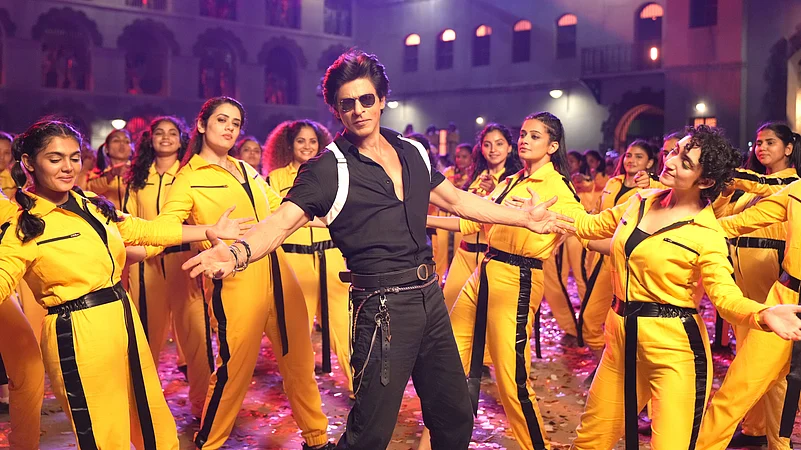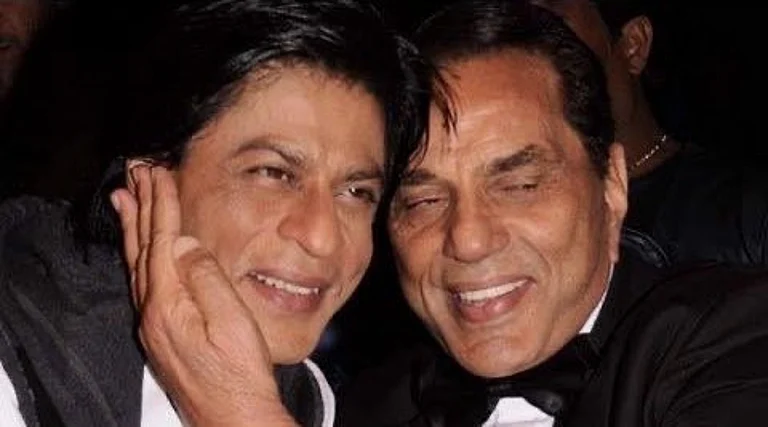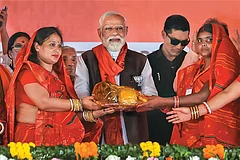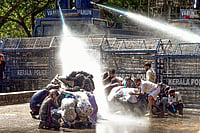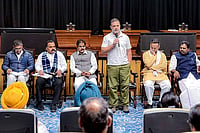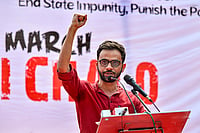
Shah Rukh Khan turns 60 on November 2, 2025.
The superstar has spent nearly four decades in Bollywood.
His next release, King, is slated for 2026.
“Do you ever imagine that someday, someone else will grace the headlines?” Anupam Kher asks.
“That’s never going to happen,” says Shah Rukh Khan, rather confidently. The audience lets out some giggles.
“I’m modest, like Anupam has already mentioned,” he continues. Kher wants to say something but Khan interrupts.
“I’ll tell you honestly. Should I just say it? I am the last of the stars,” Khan says, with cool self-assurance. The audience breaks into loud applause.
The bold declaration that Khan made in The Anupam Kher Show (Colors TV) more than a decade ago, continues to hold true for the enduring stardom of the actor in Bollywood, long after many others from his generation seem to be faltering. On May 5, Khan made his debut at the iconic Met Gala in New York, making history as the first Indian male actor at the event, apart from singer-actor Diljit Dosanjh. In September, he launched his eldest son Aryan’s directorial debut series on Netflix, The Ba***ds of Bollywood, which received raving reviews from critics and fans alike. At 60, the fact that Khan continues to hand out historical moments to his global fan base, reinforces the careful cultivation of his image as a “superstar” across the nearly four decades of his career.

Khan, or SRK—as the fond abbreviation goes—stepped into the industry during a tricky era, when the Hindi film industry was staggering out of a crisis, set into motion by the massive popularity of the video cassette recorder technology, and its consequent appropriation by the world of piracy. This was a time when the likes of Rishi Kapoor, Anil Kapoor and Mithun Chakraborty were ruling the silver screen. His contemporaries, Aamir Khan and Salman Khan had kick-started their careers with the box office success of Qayamat Se Qayamat Tak (1988) and Maine Pyar Kiya (1989) respectively. With these films, the genre of the “family film” set afoot in the industry, after a deluge of films laden with violence. On the other hand, TV—the technology taking the entertainment world by storm—became instrumental in launching SRK as a recognisable face.

A “stroke of fate” is what can describe Khan’s trajectory as a superstar most succinctly. A typical Delhi boy, Khan excelled as an “all-rounder” at school and had keen interest in sports. However, an eventual injury led him to change gear towards acting. During his college days at Hansraj college, New Delhi, he joined theatre director Barry John’s Theatre Action Group, where he studied acting under John’s mentorship. But theatre was not what gave him his big break; it was a chance encounter that made him a household name. During a house-hunting expedition with Khan’s mother, it was Fauji (1989) director Colonel Raj Kapoor’s son-in-law, who decided that Khan could be the “fresh face” that Kapoor needed for his 13-episode long Doordarshan series. Based on the training of an Indian Army regiment, the TV serial’s popularity gave Khan a chance to further his stint in television shows. But the grief of his mother’s passing pushed Khan’s sails in the direction of cinema in 1991. Though the first film he signed was the Hema Malini directed film Dil Aashna Hai (1992), Raj Kanwar’s Deewana became his debut in Hindi cinema in 1992.

Interestingly, while the other two Khans were building their way into the industry through romantic comedies, SRK made his mark primarily through the roles of an anti-hero. Both Baazigar and Darr, released in 1993, had Khan playing complex grey shades, leaving audiences mesmerised with his performance and drawing a rare sympathy for the villain in these films. This penchant for the antagonist’s role was further cemented by Anjaam in 1994, which won him the Filmfare Award for Best Villain in the following year. Though Khan was quite comfortable in this fame, legendary director Yash Chopra’s son Aditya Chopra refused to quit pursuing him for a romantic role for his directorial debut. And as fate would have it, the iconic role of Raj Malhotra in the blockbuster Dilwale Dulhania Le Jayenge (DDLJ, 1995) went to SRK, after being rejected by the three other Khans of the industry—Aamir, Salman and Saif. In October, Maratha Mandir—a theatre in Central Mumbai, historically renowned for its non-stop screening of the film since 1995—completed 30 years of screening a daily morning show of DDLJ.

The three Khans rose against a peculiar socio-historical backdrop. In many ways, their fame, specifically SRK’s, was facilitated by the formalisation of the Hindi film industry into “Bollywood”. The 1990s were a watershed moment in the nation’s history: the economy had been liberalised and markets had opened up to foreign brands and products. As a result, the film industry became a significant site of interest for potential investors and advertisers. However, the country’s socio-political landscape also saw tectonic shifts during this period. India saw a meteoric rise of the right wing against the backdrop of the Ram Janmabhoomi Movement—led by the Vishwa Hindu Parishad and other right wing outfits—and the resultant demolition of the Babri Masjid in Ayodhya in 1992, followed by communal riots. Consequently, a globalised Indian market, a rapidly transforming technoscape and the burgeoning numbers of the Indian diaspora came together, quite ironically, to popularise a marketable brand of cultural nationalism with conservative impulses, that film scholar Ashish Rajadhyaksha terms the “Bollywoodisation of Indian cinema” (2003).

This backdrop is key to understanding the early films of SRK, which laid strong foundations for his stardom. Through films like DDLJ, Pardes (1997), Kuch Kuch Hota Hai (1998) and Kabhi Khushi Kabhie Gham (2001), SRK established the on-screen image of a ‘clean’ family hero—usually an upper caste Hindu—who romanced his heroines respectfully, with blessings from the family elders.
While he danced to the tunes of the “sanskaari” playbook in movies that propounded an NRI brand of nationalist belonging, the off-screen image of SRK took a different, more secular tangent—a strong undercurrent reinforcing his stardom. SRK courted the media quite generously through talk shows and interviews during this period. The legacy of a father who took part in the Indian freedom struggle, his marriage to Gauri Khan, a Hindu woman, and an interfaith household where both Allah and Ram were worshipped, solidified Khan’s unabashed endorsement of secularism and religious tolerance. Alongside, he cultivated his outstanding rags-to-riches story by becoming the poster boy for the growing middle class that was being sold the golden dreams of global aspirations.
A “stroke of fate” is what can describe Shah Rukh Khan’s trajectory as a superstar most succinctly. His superstardom is here to stay.

In the 2000s, as the political terrain transformed and his stardom was comfortably consolidated, Khan moved towards more daring projects. At first, he met with some failures. Dreamz Unlimited—a production that he started with actress Juhi Chawla and director Aziz Mirza in 1999—produced its first film Phir Bhi Dil Hai Hindustani in 2000. While the film was a clever, almost prophetic take on the moral corruption within Indian media, it did not perform well at the box office. However, he managed to turn its fortunes by rebranding it as Red Chillies Entertainment, with his wife Gauri as its producer. The year 2004 became especially significant in his career, as three important films—Main Hoon Na, Veer-Zaara and Swades—hit the theatres, each deliciously rich with socio-political commentary in its own right.

While Main Hoon Na and Veer-Zaara batted for friendly relations with the neighbouring Pakistan, Swades spoke of recalling the NRIs to devote their energies towards the betterment of their own country. Later, Chak De! India (2007) and My Name is Khan (2010) saw Khan own his Muslim identity on-screen, confronting the persecution and discrimination that the religious minority faced at home and beyond. Chak De! India’s massive success lay in speaking of a nationalism that did not need to subsume the Muslim identity of its protagonist, nor treat it with animosity, to propagate love for one’s nation. This was truly a period when Khan’s on-screen and off-screen personalities did not stand as a paradox; instead, they resonated and complemented each other.

One of the most intelligent strategies of Khan’s superstar image has been his cinephilic references to his own earlier performances—a classic move through which the star evolves across films. Be it his iconic posture with his widespread arms, the extreme close-up shots of his eyes or his unique patterns of romance as Raj or Rahul, SRK effectively recycles his image across films through symbolism that is immediately recognisable by the audience. Both Om Shanti Om (2007) and Fan (2016) play on this star image brilliantly, to turn tales about film stars and the film industry into thrillers. His 2013 film Chennai Express also capitalised on this strategy to deliver a comic potboiler.

As the political winds blew to the right once again after 2014, Khan began to be attacked for his public stances and his Muslim identity. In 2015, on the occasion of his 50th birthday, Khan made statements about the rising religious intolerance—in the aftermath of the Dadri lynching of Mohammad Akhlaq on the suspicion of cow slaughter—during multiple media interactions. This came at a heavy cost. From calls of boycotting his films to connecting him to Pakistani terror outfits, right wing organisations had a field day bashing the superstar across social media platforms. The incident pushed him to curb his openness with the media. Yet, his most powerful commentary on communalism came in the form of Raees in 2017, where he played a Muslim Shia gangster leading a kingdom built on bootlegged alcohol in Gujarat, a dry state. The film, a commercial hit, includes an unforgettable scene, where Raees stops a rath yatra from entering his area. It harks back to Lal Krishna Advani’s rath yatra during the Ram Janmabhoomi movement; except here, it serves as a potent alternative imagination. Raees was not devoid of controversies—post the 2016 Uri attack, Pakistani artists were banned from Bollywood, and Khan had to personally meet Maharashtra Navnirman Sena chief Raj Thackeray to assure him that Pakistani actress Mahira Khan, who starred opposite Khan in Raees, would not be part of the film’s promotion.
Raees was followed by a couple of flops like Jab Harry Met Sejal (2017) and Zero (2018), after which Khan took a four-year hiatus from the big screen. During this time, another political storm wrecked havoc in his personal life. In 2021, during the Covid pandemic, his eldest son Aryan Khan was arrested on drug charges by the Narcotics Control Bureau—a case that many cited as a “political vendetta” against Khan’s outspokenness on matters of national importance. Though his son was released on bail 26 days later, the massive fan base of the superstar was incensed by this personal attack.

Public sympathy for Khan eventually poured into the skyrocketing success of his 2023 year-opener Pathaan, a spy thriller where Khan played an exiled agent in the service of national security. The meta-textual readings of Pathaan were not lost on critics—hat tips to Khan’s stardom were strewn liberally across the film, including a climactic sequence with Salman Khan. The year also saw the releases of Jawan and Dunki, of which Jawan surpassed the numbers of Pathaan. Jawan—where Khan plays a jailor on a mission to redress the corrupt practices of the politician-gangster syndicate—owed its success to Khan’s intelligent collaboration with Tamil director Atlee Kumar, bringing in the formula of Tamil cinema to rejuvenate decaying Bollywood strategies. In September, Khan received a National award for his performance—the first in his career.
As fans await his next release King, slated for 2026, one thing remains clear: no matter the noise of controversies or the ebbs and flows of his career, SRK’s ability to reinvent himself with the times and harness his personal challenges into his star status translates into a superstardom that is here to stay.
MORE FROM THIS ISSUE
Apeksha Priyadarshini is senior Assistant editor, Outlook. She writes on cinema, art, politics, gender & social justice







